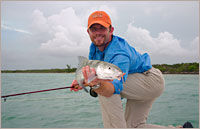
First, practice your casting. Most bonefish are caught within 40 feet, but that 40-foot cast must be made quickly, under pressure, with deadly accuracy, and with the good chance of a stiff breeze. Being able to get 40 feet of fly line outside the rod tip is not enough. Pace out 40 feet and make sure you can hit a target the size of a hula hoop with reasonable consistency, with a wind coming from any direction, and be able to change directions to cast to another hula hoop with just one false cast. Bonefish are spooky critters and too many false casts will ruin your chances.
Either before your trip or just after you arrive, take a heavily weighted (also called deep version)
Either before your trip or just after you arrive, take a heavily weighted (also called “deep” version), lightly weighted (shallow version), and unweighted (tailing version) bonefish fly to some shallow water where you can see the fly sink. Watch how fast each fly lands, as having different sink rates in bonefish flies is far more important that having the favorite fly on the island. Over sand and mud bottoms you want the fly to sink to the bottom and make little puffs of silt when you strip, because these plumes attract the attention of a bonefish looking for a crab or shrimp trying to escape. Over weedy and coral-covered bottoms, a bonefish can’t see a fly that sinks down into the debris (and you’ll get hung up) so you’ll begin to strip your fly before it hits bottom. And you never know beforehand how deep the water will be on a given flat, so you must have some idea of how fast your fly will sink—and be prepared with flies with different sink rates.
|
Steve Hemkins, Senior Product Developer at Orvis Rod & Tackle, with a great bonefish catch. |
No matter how good you are at spotting trout or steelhead, you will have trouble seeing bonefish in the water, at least for the first day and probably for a couple of days. Count on it. Bonefish are nearly invisible underwater because their shiny sides reflect the bottom, and without a shadow to pinpoint their position you’ll have a very difficult time. If you are unlucky to have a week of cloudy weather you may see very few of them unless they are tailing in shallow water. Some guides are excellent at helping clients learn to spot bonefish, others, because of a language problem or reticence, just tell their anglers where to cast and forget about trying to teach them. Try to discipline yourself to see through the water, not at it, and remember that bonefish hardly ever stop moving, so look for shadows and grayish indistinct shapes that don’t stay put.
Once you get onto a boat with a guide, remember that he will be giving you directions to cast by the hands of a clock in relation to the boat. Twelve o’clock is always directly in front of the boat, not where you are looking. And you will get befuddled—guaranteed. I don’t know how many times I’ve had a guide say “Cast 30 feet at 9 o’clock.” Sigh. “ No. The other 9 o’clock.” I even saw an enterprising young Bahamian guide on my last trip who had painted the hands of the clock, including the numbers, on the bow of the boat, just for clods like me.
The other miscommunication with guides and clients is distance. Different people have different ideas of what 40 feet is, especially in the heat of the moment. Make a short and a long cast before you start and ask your guide how far the casts were. If you’re traveling to Mexico or Central America, it’s not a bad idea to learn the words for 20, 30, 40, 50, and 60 feet before you leave.
Finally, the strike is the bane of all trout anglers. You should never strike a bonefish (or any saltwater fish) with the rod tip, but by making a long, firm strip with the line while the rod is held low. Raising the rod tip lifts the fly out of the water, and if a bonefish hasn’t really taken it or misses the fly, it may come back to a fly that just makes a long dart through the water rather than one that goes airborne. (Many guides, when they see a bonefish take a fly, will instruct the angler to “make a long strip” because they know if they say “strike” up will come the rod tip.) One of the best suggestions I’ve heard for people who cannot modify their reflexes to strip strike is to retrieve a bonefish fly with the rod tip help a few inches underwater throughout the retrieve. With the tip underwater, the line stays in excellent control and it’s almost impossible to make a “trout strike.”
Places for Bonefishing
If you’ve never fished for bonefish before, probably the easiest place to learn is in Belize, where fish are smaller but very numerous. The Bahamasis also a good place for the beginner, although the fish are bigger and sometimes not as easy. Fell free to call the experts at Orvis International Travel. They’re experts at matching your fishing skills and desires with the right location, and will also help you find the right location for non-fishing members of your family. To Contact Orvis Travel: Call us at 800-547-4322 or e-mail us at
Advice on Bonefishing Gear
If you need advice on what gear you need, you can view our complete bonefishing package online, or call our fishing expert line at 1-800-548-9548 for help every step of the way.





